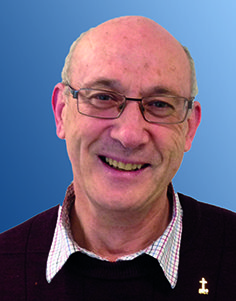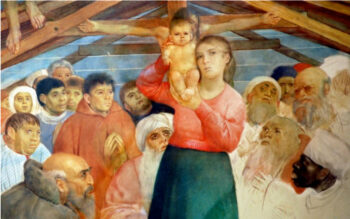Marist Spirituality: An Introduction – Part 7
One 'Yes' Three 'Nos'

By Fr David Kennerley SM
Father Jean-Claude Colin was a product of his times. Having endured the horror of the French Revolution, along with its Napoleonic aftermath, and then having to contend with the all too frequent political upheavals where monarchs and republics rose or fell, it is little wonder that he, like so many other French, looked to Mary. What stands out regarding Colin and the first Marists, however, is their utter conviction that Mary herself undertook an initiative with them saying, “This is what I want…”
The request originating at Le Puy in 1812 galvanised the first Marists to work to establish a Society of Mary. However, what is perhaps most striking about Colin, is that he understood these words to have ramifications that far exceeded the concerns of his times and indeed of his little Society of Mary. He believed that Mary’s initiative and her ongoing presence in the Church, meant that ‘the Church of the end times’ was now emerging more to the fore.
The Church of the end times for Colin was, of course, still Petrine, the Church of Peter and the apostles. However, Marists especially were now to say ‘Yes’ to this emerging more Marian Church, a Church characterised by a mother’s sensitive, very active concern for her struggling and lost children.
Colin himself was very aware of the challenge in this. In his words, “the Society of Mary was not to model itself on any other existing congregation.” Its vision was to be much more far-reaching than being set on merely completing just the regular everyday tasks of service in the Church. All Marists, whether vowed Religious or Laity, were to grasp that Mary was intent on achieving something much more than this, even when working on their ordinary tasks. A new way of being Church was to mark what Marists did. Accordingly too, Marists could engage in all manner of evangelising works. This task was so vital, so necessary now for Colin, that Marists were not to be tied to just one or two so-called traditional apostolic works.
This Colinian theme, then, cries out for laity to practice it in their own right, women and men, young and old, taking to heart the challenge “to think as Mary, judge as Mary, feel and act as Mary in all things” and thereby, be a catalyst for transforming how the Church and even society itself thinks and behaves. Colin even dared to dream of the whole world eventually doing this, at which point, Mary, this great woman of hope, would have helped achieve as it were, a second incarnation – and at least in part, through us.
For Colin, Mary was the critical foil to what he saw as the three great obstacles disfiguring the Church of his day – greed, pride, power. There was widespread clerical greed and pressure to return to heavy Church taxes. Also, Catholics at every level, were too intent on the Church regaining its position of privilege and influencing control in society, (both local and national) which had been lost to the Revolutionaries and their enduring Enlightenment ideas. Worse still, the Church was seemingly blind to the alienating effects this clamouring and negativity towards the changed landscape continued to have on ordinary people.

Madonna by Charles-Louis Rivier
Consequently, Marists, because they were to be so mindful of Mary, had to practice a truly vigorous NO to any thought or action that even hinted at one of these three forms of self-seeking within them. In Colin’s mind greed, pride and power were the very antithesis of who Mary was both as a person and as a disciple of Jesus her son.
To be a Marist, really does mean letting Mary ‘get under our skin’ and into our everyday less-redeemed attitudes and behaviours. We do this so that the world will see what hope the Church, and the Gospel can have, when embodied in a person or a people taking on Mary’s dispositions, her likeness.
The request originating at Le Puy in 1812 galvanised the first Marists to work to establish a Society of Mary. However, what is perhaps most striking about Colin, is that he understood these words to have ramifications that far exceeded the concerns of his times and indeed of his little Society of Mary. He believed that Mary’s initiative and her ongoing presence in the Church, meant that ‘the Church of the end times’ was now emerging more to the fore.
The Church of the end times for Colin was, of course, still Petrine, the Church of Peter and the apostles. However, Marists especially were now to say ‘Yes’ to this emerging more Marian Church, a Church characterised by a mother’s sensitive, very active concern for her struggling and lost children.
Colin himself was very aware of the challenge in this. In his words, “the Society of Mary was not to model itself on any other existing congregation.” Its vision was to be much more far-reaching than being set on merely completing just the regular everyday tasks of service in the Church. All Marists, whether vowed Religious or Laity, were to grasp that Mary was intent on achieving something much more than this, even when working on their ordinary tasks. A new way of being Church was to mark what Marists did. Accordingly too, Marists could engage in all manner of evangelising works. This task was so vital, so necessary now for Colin, that Marists were not to be tied to just one or two so-called traditional apostolic works.
This Colinian theme, then, cries out for laity to practice it in their own right, women and men, young and old, taking to heart the challenge “to think as Mary, judge as Mary, feel and act as Mary in all things” and thereby, be a catalyst for transforming how the Church and even society itself thinks and behaves. Colin even dared to dream of the whole world eventually doing this, at which point, Mary, this great woman of hope, would have helped achieve as it were, a second incarnation – and at least in part, through us.
For Colin, Mary was the critical foil to what he saw as the three great obstacles disfiguring the Church of his day – greed, pride, power. There was widespread clerical greed and pressure to return to heavy Church taxes. Also, Catholics at every level, were too intent on the Church regaining its position of privilege and influencing control in society, (both local and national) which had been lost to the Revolutionaries and their enduring Enlightenment ideas. Worse still, the Church was seemingly blind to the alienating effects this clamouring and negativity towards the changed landscape continued to have on ordinary people.
Consequently, Marists, because they were to be so mindful of Mary, had to practice a truly vigorous NO to any thought or action that even hinted at one of these three forms of self-seeking within them. In Colin’s mind greed, pride and power were the very antithesis of who Mary was both as a person and as a disciple of Jesus her son.
To be a Marist, really does mean letting Mary ‘get under our skin’ and into our everyday less-redeemed attitudes and behaviours. We do this so that the world will see what hope the Church, and the Gospel can have, when embodied in a person or a people taking on Mary’s dispositions, her likeness.
A Prayer
Come Holy Spirit,
touch our minds,
move our hearts,
that we might be present in the Church in Mary’s way.
Help us “to love the Church as it is while at the same time being an agent of its renewal and unity”.
Remove from us all those attitudes that work against this great work.
An Insight
“Under the guise of a warning against a few excesses, there is a profound criticism of a whole set of behaviour within the Church. Colin rejects three forms of power: the power which comes from money, the power which comes from having within one’s hands the key to decision making, and to power which comes from prestige.
When the apostle lets a seeking for power come into his heart, can he still say that he is speaking of Christ, that he is announcing the kingdom of God? When confronted with a Church with these kinds of behaviour, what is needed is not another Church but another kind of Church which we must make new again by transforming it.” (Jean Coste, A Marian Vision of the Church, pp.384 – 386).
QUESTIONS TO PONDER
1. Ponder for a moment on all that you love about the Church, locally and internationally. Wonder about how it has remained in existence for so long, meeting challenges and yet adapting.
2. Do you feel challenged or even called in some way by the twin task of “being an agent of the Church’s renewal and unity”?
 Entries(RSS)
Entries(RSS)